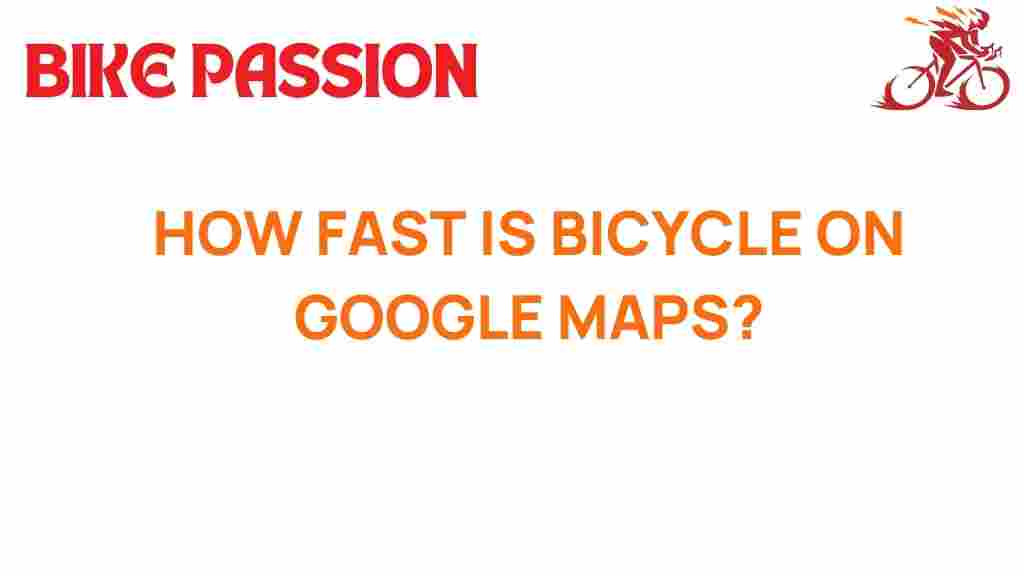Unveiling the Speed of Bicycles on Google Maps: What You Need to Know About Bicycle Speed
In today’s fast-paced world, urban cycling has gained immense popularity as an effective and eco-friendly mode of transportation. With the rise of navigation tools like Google Maps, cyclists can now plan their routes efficiently while estimating travel times. Understanding bicycle speed and how it affects cycling efficiency is crucial for any cyclist, whether you’re commuting or exploring new trails. In this article, we will delve into the nuances of bicycle speed in Google Maps, offering insights, tips, and tricks to enhance your cycling experience.
Understanding Bicycle Speed
Bicycle speed plays a significant role in determining how long it will take to reach your destination. Generally, the average cycling speed for most people varies based on several factors:
- Rider fitness level: Experienced cyclists can maintain higher speeds compared to beginners.
- Terrain: Flat roads allow for faster speeds than hilly or rough terrain.
- Bicycle type: Road bikes typically achieve higher speeds than mountain bikes.
- Weather conditions: Wind, rain, and temperature can impact speed significantly.
On average, cyclists can expect speeds between 12 to 20 miles per hour depending on the aforementioned factors. Understanding these variables is essential for effective route planning and travel time estimation.
Using Google Maps for Cycling Efficiency
Google Maps serves as a powerful tool for cyclists, providing not just directions but enhancing cycling efficiency through various features.
- Cycle-specific routes: Google Maps offers cycling routes that consider bike lanes and paths, ensuring a safer journey.
- Real-time traffic updates: Knowing the traffic conditions can help avoid congested areas and improve travel time estimation.
- Distance measurement: You can easily assess how far your destination is and gauge the time required based on your cycling speed.
To make the most out of Google Maps, ensure you have the latest version of the app and familiarize yourself with its cycling features.
Step-by-Step Guide to Using Google Maps for Biking
Here’s a simple guide to help you navigate Google Maps effectively for your next cycling adventure:
- Open Google Maps: Launch the app on your mobile device.
- Select Directions: Tap on the ‘Directions’ button.
- Choose Cycling Mode: Select the bicycle icon to specify that you’re cycling.
- Enter your starting point and destination: Input where you are and where you want to go.
- Review the suggested routes: Google Maps will present multiple cycling routes; choose one that suits your preferences.
- Check travel time estimation: Review the estimated travel time based on your cycling speed and selected route.
- Start your journey: Follow the guided directions as you cycle.
By following these steps, you can enhance your cycling efficiency and make informed decisions about your route planning.
Tips for Improving Your Bicycle Speed
To optimize your travel time and cycling experience, consider the following biking tips:
- Maintain your bicycle: Regular maintenance, including tire pressure checks and lubrication, can significantly enhance your bike’s performance.
- Improve your fitness: Incorporate strength and endurance training into your routine to boost your cycling speed.
- Choose the right gear: Wearing appropriate cycling attire and using a lightweight bike can improve your speed.
- Plan your route: Use Google Maps to select routes with fewer stops and obstacles to maintain a steady speed.
Troubleshooting Common Issues While Using Google Maps
While Google Maps is a fantastic tool, you might encounter some issues. Here are some troubleshooting tips:
- GPS signal loss: If your GPS signal is weak, try moving to an open area for better reception.
- Incorrect travel time: If your estimated travel time seems inaccurate, adjust your cycling speed in the settings.
- App crashes: Ensure your app is updated to the latest version to avoid crashes during use.
By being aware of these common issues, you can ensure a smoother experience while navigating.
Estimating Travel Time Effectively
Estimating travel time accurately is essential for planning your rides. Here’s how to do it:
- Know your average speed: Use a cycle computer or app to track your average speed over different terrains.
- Factor in breaks: Include time for rest stops, especially on longer rides.
- Consider traffic conditions: Use Google Maps to check for traffic that might slow you down.
By combining these factors, you can have a more accurate estimation of your travel time, allowing for better planning.
The Future of Urban Cycling with Technology
As urban cycling continues to evolve, technological advancements are playing a significant role. New apps and tools are being developed, making navigation even easier and more efficient for cyclists. Here are a few trends to watch:
- Smart helmets: These helmets come equipped with navigation systems, allowing for hands-free directions.
- Integrated bike computers: Devices that sync with your smartphone to provide real-time data on speed, distance, and routes.
- Community-driven apps: Platforms that allow cyclists to share their routes and tips with others for improved cycling experiences.
Staying up-to-date with these technologies can significantly enhance your urban cycling experience, allowing for greater efficiency and safety on the road.
Conclusion
Understanding bicycle speed and how to leverage Google Maps effectively can significantly improve your cycling efficiency. With the right planning and tools, you can enhance your travel time estimation, choose the best routes, and enjoy a smoother ride. Remember to practice good biking habits, maintain your bicycle, and continuously look for ways to improve your performance. As urban cycling becomes increasingly popular, the integration of technology will further facilitate a growing community of cyclists. For more biking tips and resources, check out our cycling guide. Embrace the joy of cycling and make the most of your urban journeys!
For further reading on biking and urban cycling, visit this informative resource.
This article is in the category Routes and created by BikePassion Team
